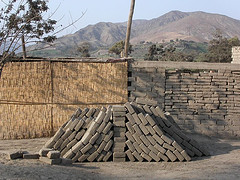Friday Rock Blogging: Clay
 NASA’s press machine is unbeatable this week. Everywhere you look (for values of “everywhere” limited to science sections of the popular press) you see the same pictures of Enceladus spewing out its watery spew - but all us cool kids have been seeing these pictures for months and we’re sick of ‘em*. No, today’s Friday Rock Blog is about something way sexier and more exotic than a silly Saturnian moon - it’s about clay!
NASA’s press machine is unbeatable this week. Everywhere you look (for values of “everywhere” limited to science sections of the popular press) you see the same pictures of Enceladus spewing out its watery spew - but all us cool kids have been seeing these pictures for months and we’re sick of ‘em*. No, today’s Friday Rock Blog is about something way sexier and more exotic than a silly Saturnian moon - it’s about clay!
One of the few articles in this week’s issue of Science that isn’t about the Cassini mission is a report from Martin Kennedy and colleagues on the rise in clay mineral concentration in the late Neoproterozoic, aka Just Before Multicellular Organisms. Modern microbial crusts speed up the process of turning feldspar into clay, so Kennedy et al. hypothesize that the beginning of life on land was responsible for the change.
The surfaces of clay minerals (including such stars as illite and smectite) like to grab organic carbon. These minerals also occur in very small grains, so in your standard-size adobe brick, there’s an awful lot of surface area and, potentially, a lot of carbon. This makes clayey soil an effective way to grab carbon from the atmosphere and hide it away at the bottom of the ocean. So: alter the weathering cycle, change the carbon cycle, change everything, dude, like, whoa.
*Well, we’re not actually sick of Enceladus - and I for one am a sucker for the word “geyser” so my interest is guaranteed for some time to come. But I’m kind of cranky this afternoon (programming is never a mood-lifter for me) and I thought maybe a spot of sniffy better-than-youness would be nice.
delagar wrote:
Oh, bliss, friday rock blogging!
I like that bit about pulling the carbon from the atmosphere.
Hey, how does mudstone relate to clay? Or does it?
Posted 14 Mar 2020 at 7:37 am ¶
Lab Lemming wrote:
Mudstone is made primarily of clay and clay-sized grains of other minerals Unlike shale, mudstone lacks foliage, suggesting that the constituient clay minerals do not have a preferred orientation.
-LL
Posted 17 Mar 2020 at 10:48 pm ¶